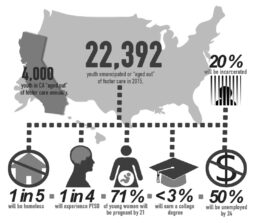Just the brush of skin on skin or a hug is enough to spark Aragon alumna Sheila’s* discomfort, prompting her to shy away from physical engagement. Too much contact triggers the flood of overwhelming, traumatizing memories that she wishes to never relive again. Sheila is a survivor of rape, which is legally defined as non-consensual penetration of sex organs with any body part or non-consensual penetration of the mouth with any sexual organ. Sheila was enjoying the summer break of her junior year when her rape story occurred, but even now, the moment continues to scar her memories.
Sheila remembers the terror and panic she felt when she realized what was happening. The heavy weight of her much larger counterpart pinned her and rendered her flailing legs useless, so she could do nothing except scream at him to stop. However, her screams proved as fruitless as her attempts to escape as he forcefully continued on anyway. Sheila knew she was powerless, and gave up fighting, both mentally and physically, as someone who she used to consider as a friend violated her body, her spirit and her will. “I walked away feeling dirty and incredibly insecure … after having ‘that’ be done to you, you kind of lose sense of yourself,” says Sheila.
The hurtful reality of the assault on Sheila lingered for much longer than after her assaulter left. She remembers staying at home barricaded in her room for days, emerging only to eat, and refusing to talk to anyone. “I couldn’t do … anything at all,” Sheila says, “I felt like my world came to a hole … I know I wasn’t myself because I’m very social and I’m very talkative, but everyone noticed that I wasn’t myself for a good week.”
Sheila’s original inability to function was a symptom of both post traumatic stress disorder (PTSD) and acute stress disorder, common effects resulting from scarring experiences like rape, molestation, catcalling, inappropriate groping or verbal assault.
In cases of acute stress disorder, feelings of fear, anger, guilt and anxiety are usually triggered immediately after the event, but usually retreat after about three months. Conversely, unusually strong feelings that impede an individual’s life are associated with PTSD and do not fade. Instead, they get stronger until the victim is overwhelmed and unable to function. 94 percent of women who were rape victims experienced PTSD two weeks after their assault, and some endure it throughout their lifetime.
However, PTSD can be treated, and the recovery from acute stress disorder can be stimulated with appropriate support and care. Therapy and medical options are available at clinics, offices and schools, but Sheila, who has kept her confidant group small, cites three of her friends as the main source of her strength and support during the time; “It helps knowing that there’s someone I can talk to,” Sheila says.
The National Center for PTSD affirms that keeping strong bonds between friends or family and the victim after an assault is essential in the recovery or treatment of stress from assault. Extending sympathy to the victim, encouraging contact between the victim and close friends or family, and urging the victim to participate in physical activities are all simple efforts that family and friends are suggested to invest in.
Junior Eva*, a survivor of child molestation and assault, also acknowledges the importance of the moral support, but points out another crucial benefit to confiding a trusted group of individuals, which in her case, are her friends. She says, “I think [having a strong support system is] really important because a lot of [other] people … can really make a victim feel like ‘Oh, it really was my fault,’ but it’s not. There’s just these terrible people and they do terrible things.”
The truth is that rape is never a victim’s fault and assaulters lawfully deserve to be sentenced. However, the “boys will be boys mentality” embedded within societal norms undermines the progress of bringing justice and condemning rape in society, especially with female victims. While both males and females are both sexually assaulted, an overwhelming majority of sexual assaults, especially rape, have indeed targeted women. Nine out of ten adult rape victims and 82 percent of child rape victims are reportedly female.
Society is quick to blame victims of rape and view male sexual violence as acceptable if a female victim is scantily dressed, intoxicated, under the influence or otherwise in a compromising position for the situation.
Intoxication and “promiscuity” were precisely two factors that Brock Turner’s defense lawyer argued were sufficient justifications to excuse Turner from his charges in the infamous People v. Turner case after Turner, a former Stanford All-American swimmer, was accused of raping a woman behind a dumpster at a fraternity party in Jan. 2015. After a year in court, Turner was sentenced to only six months in jail in June 2016, far more lenient than the minimum three-year imprisonment mandated by California law for accounts of rape, and even more lenient than the six-year imprisonment that the prosecution argued for.
Because the victim was intoxicated and could not remember the events of that night, the defendant’s lawyer faulted her for not knowing better and dismissed her as unreliable and discredited, stating that Turner’s remembrance was the only accurate account, despite the deviation from his original testimony when he was brought to court.
Turner also incorrectly saw his wrongdoing as drinking, using both his and her intoxication as an excuse, and did not acknowledge that sexually penetrating the victim without consent was also immoral and wrong. “Sipping fireball is not your crime,” the victim narrated in court, “Peeling off and discarding my underwear like a candy wrapper to insert your finger into my body is where you went wrong.”
Along with intoxication, wardrobe, junior Edie Miller asserts, also cannot be used to blame a victim in a case of sexual assault. “No one wants to be violated. What a girl or boy wears does not invite someone to touch them or to say gross things to them. What we wear is none of their business and we’re not wearing it for them,” says Miller.
This culture not only makes an appearance in public news, as Eva has also experienced the societal bias first hand. When she approached her parents for an explanation of the molestation she was subjected to when she was eight, Eva’s mother responded, “Oh, you know, boys do a lot of show and tell.” The response is not atypical under the influence of community norms; because Eva’s assailant was male, his actions were not worthy of indignation, though they are punishable by imprisonment.
It’s unsurprising that Eva reacts differently than her mother. “[The event] makes me just really upset because I feel like girls are taught like ‘Hey, follow these steps so you won’t get assaulted or raped.’ But I feel like nobody really sits boys down and is like ‘Hey, don’t assault girls,’” says Eva.
Blaming victims and allowing unacceptable justifications of actions contribute to the frighteningly low rates of convicted and imprisoned sexual assault offenders. The Bureua of Justice statistics reports that only around 0.6 percent of offenders are put into prison, and only 33.6 percent of all sexual assault and rape cases get reported to the police. Sexual assault victims often do not feel like they can find help from law enforcement, as many are weighed down by self-blame, shame, humiliation, fear of not being believed and a lack of trust in the criminal court system. Miller says, “A lot of it is like they blame the victim and it’s really unfair. It’s just like you really think they wanted this to happen to them? Or they just don’t believe them. Which is just gross. I’ve heard stories of cops just dismissing it, like not even filing a report.”
Miller’s speculations play straight into Sheila’s fears, who explains why she avoided police interaction, saying “I was afraid that most people wouldn’t qualify it as rape, like people would be like “Oh, you’re just doing this to get attention” and I felt like other people wouldn’t understand.”
Miller herself was catcalled multiple times by older men when she was younger. She recalls, “I was on my own street, and guys would like honk at me and like yell like ‘hey baby’ or other obscene things. And it’s really scary to be catcalled because whatever your reaction is, there’s always the possibility they’ll take it, not really in the wrong way, but become violent.”
Sexual assaults don’t hurt like broken bones or lacerations. Physical wounds may accompany the assaults, but damage is always wreaked on the individual’s mind and spirit. The men catcalling Miller didn’t have to touch her to scare her and make her feel “gross and insecure.” Eva wasn’t covered in bruises or scratches, but was still non-con sensually violated. Sheila didn’t have to be tied down to feel like she couldn’t fight. Bones mend, cuts scab, but trauma trails shortly after an assault, and prods constantly at the sores on the spirit.
*Names have been changed to respect our sources’ anonymity.



